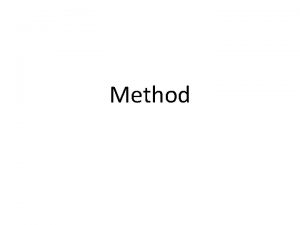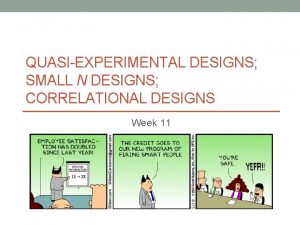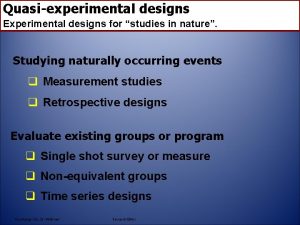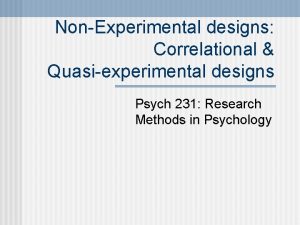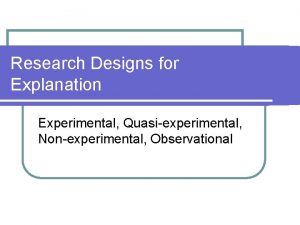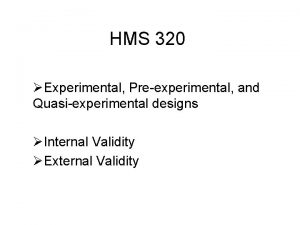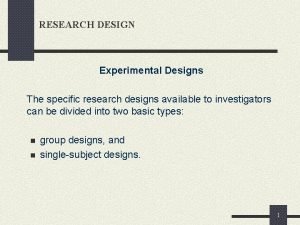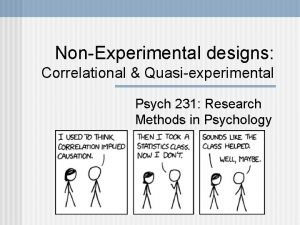Choosing Research Designs I Experimental and QuasiExperimental Experimental















- Slides: 15

Choosing Research Designs I Experimental and Quasi-Experimental

Experimental Designs • Experimental research design: The researcher has control over the experiment in terms of sample selection, treatment, environment, etc. • Experimental designs are typical in psychology, medicine, education, etc.

Experimental Designs Experiments often discuss pre and post test observations • POST-TEST ONLY X O 1 Where: 0 t = Observation in time t of experimental group X = Treatment 0 c = Control group

Experimental Designs • PRE-TEST POST-TEST O 1 X O 2 Note how the above test includes no control group. What is a control group and why include it? • PRE-TEST POST-TEST WITH CONTROL GROUP O 1 X O 2

Key question of Internal Validity • When we test a hypothesis and either accept it or reject it, how do we know that we made the right decision? • What about alternative explanations that we did not account for? • What should we do to gain confidence?

Internal Validity • Are there other causes for what I am observing? • If so, a study will lack internal validity if it cannot rule out plausible alternative explanations.

Internal Validity of a Study Is the relationship causal between. . . • What you measured and what you saw? • Your program and your observations? Alternative cause Research Project What you do Observation Program-outcome Relationship Observations What you see Alternative cause In this study

• DID YOU FIND THAT BORING? THEN HOW ABOUT A JOLT OF CUTENESS!

Experimental Designs • What do you do if you fear that your simple pre and post test single observations are atypical? • CONTROL WITH MORE OBSERVATION IN THE PRETEST O 1 O 2 O 3 X O 4

Experimental Designs • Of course, we could also experiment to see if removing a factor has an effect instead of adding a treatment factor • PRE-TEST POST-TEST REMOVING THE TREATMENT O 1 X O 2 _ X O 3 X 04

Experimental Designs Research design with more power to control for time • Pre-test post-test O 1 O 2 O 3 X O 4 O 5 O 6 • Pre-test post-test with control group O 1 O 2 O 3 X O 4 O 5 O 6

Did you bring your lab coat? • Considering true experiments are close to impossible or unethical in political science, we need to apply science differently. • Hence, this is why we in political science often use Quasi-experimental or nonexperimental research designs

Quasi-Experimental • Quasi-experiments: The researcher does not have control over the experiment, rather the experiment occurs in a “natural” setting. • Quasi-experimental design are typical in economics, sociology, public administration, urban planning, political sciences, etc.

Quasi-Experimental • A prominent example of this type of research is arguably by Samuel Huntington, who argues that Latin American immigration, especially Mexican, is altering US culture for the worse. • He essentially predicts that the United States will be a divided, less productive, society, ruining the past culture that has made the United States great. http: //www. foreignpolicy. com/story/cms. php? story_id=2495

Quasi-Experimental Huntington points out the following X variables: • Proximity of Mexico, Latin America to USA • Former ties to Mexico • Magnitude of recent wave of immigration • Duration of recent wave of immigration • Illegality He does this by observing what is going on today. It is crucial that one understands his assumptions and evaluates what he claims as evidence for his theory
 Casual comparative vs. comparative
Casual comparative vs. comparative Quasi-experimental research designs
Quasi-experimental research designs Quasi-experimental research designs
Quasi-experimental research designs Disadvantages of experimental research
Disadvantages of experimental research 11 principles of design
11 principles of design Block design vs matched pairs
Block design vs matched pairs Design research meaning
Design research meaning Basic principles of experimental designs
Basic principles of experimental designs Research instrument in experimental research
Research instrument in experimental research Research instrument in experimental research
Research instrument in experimental research Exploratory, descriptive and causal research
Exploratory, descriptive and causal research Experimental vs non experimental
Experimental vs non experimental Experimental vs non experimental
Experimental vs non experimental Experimental vs nonexperimental
Experimental vs nonexperimental Nonexperimental study
Nonexperimental study Qualitative paper example
Qualitative paper example









